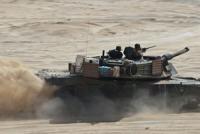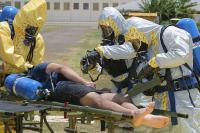-
U.S. military challenged by other nations’ improved abilities to deny access to territory

A U.S. military strategy based primarily on an ability to deploy troops anywhere it feels necessary will face heightened costs and risks in critical regions by 2025, owing to other nations’ improved abilities to deny the U.S. access, according to a new study. Anti-access and area denial are the two biggest threats to the U.S. ability to project its military forces.
-
-
Special forces should be at the heart of Britain’s military planning
What sort of military does the United Kingdom need to deal with a rapidly changing set of potential threats? As Western countries increasingly move away from the conventional foe — one that is easily identified, armed in a similar way and which, most critically, thinks in a similar way, and therefore in a conventional and predictable manner – it’s time to reappraise the sort of armed forces required for the future. It is no longer the size of your arsenal of firepower but how well it is employed that matters. Organizations such as Islamic State understand that well: their actions are carefully targeted to achieve maximum effect with limited resources. With technology on the Western side, the best counter to this present – and likely future – threat, will be to adopt in turn Voltaire’s maxim and concentrate increasingly on special, and specialized, forces.
-
-
Sled track simulates high-speed accident in B61-12 nuclear weapon test
Sandia National Laboratories has sent a mock B61-12 nuclear weapon speeding down the labs’ 10,000-foot rocket sled track to slam nose-first into a steel and concrete wall in a spectacular test that mimicked a high-speed accident. It allowed engineers to examine safety features inside the weapon that prevent inadvertent nuclear detonation. Data analysis from the test continues, and the information will help engineers better understand how systems respond in abnormal environments — accidents or other unexpected events.
-
-
U.S.: UN should investigate war crimes committed by Russia, Syria in Aleppo
U.S. Secretary of State John Kerry said that the military campaign by Russia and Syria against civilians in Aleppo amounts to a war crime, and that the UN must launch a war crime investigation into the two countries’ actions. Military analysts noted that the Russian and Syrian campaign aims not only to kill civilians directly by dropping barrel bombs on Sunni neighborhood. Assad and his Russian allies deliberately increase the death toll by using bunker-busting munitions systematically to destroy the city’s civilian infrastructure — hospitals, clinics, water treatment facilities, and power stations. The analysts say that Assad’s ultimate goal is to make life in the city impossible, thus forcing hundreds of thousands of Sunnis to flee, making it easier for his Alawite and Shi’a forces to control the city once they recapture it from the rebels.
-
-
A military view on climate change: It’s eroding our national security and we should prepare for it
U.S. military leaders and defense planners have been studying climate change for years from a perspective that rarely is mentioned in the news: as a national security threat. And they agree that it poses serious risks. Here is how military planners see this issue: We know that the climate is changing, we know why it’s changing, and we understand that change will have large impacts on our national security. Yet as a nation we still only begrudgingly take precautions. The next president will have a choice to make. One option is to continue down the path that the Obama administration has defined and develop policies, budgets, plans, and programs that flesh out the institutional framework now in place. Alternatively, he or she can call climate change a hoax manufactured by foreign governments and ignore the flashing red lights of increasing risk. The world’s ice caps will not care who is elected or what is said. They will simply continue to melt, as dictated by laws of physics. But Americans will care deeply about our policy response. Our nation’s security is at stake.
-
-
Terrorism fallout shelters: Is it time to resurrect nuclear civil defense?
Fifty-five years ago, on 6 October 1961, President John F. Kennedy advised Americans to build an underground protective room, commonly known as a “fallout shelter,” in their homes. The American people heeded his advice and began an enormous grassroots effort to construct fallout shelters in every private residence and public building. Today, smaller nations and terrorist groups, such as al-Qaeda, are seeking nuclear weapons. Some nations, like North Korea, already have them. Others may be a decade away. It is not unreasonable to believe that the use of a single nuclear weapon by a rogue nation or a terrorist group now poses a more likely scenario for a nuclear confrontation than a nuclear war between Russia and the United States. We need a strategy to protect ourselves against these adversaries, and right now we don’t have one, except screening cargo. If we don’t find a more effective strategy to thwart nuclear terrorism soon, we may be forced to go back to fallout shelters as our only protective option, whether we like it or not.
-
-
A nerve agent antidote taken before a chemical weapons attack

Nerve agents are molecular weapons that invade the body and sabotage part of the nervous system, causing horrific symptoms and sometimes death within minutes. Few antidotes exist, and those that do must be administered soon after an attack. Now, scientists an early-stage development of a potential treatment that soldiers or others could take before such agents are unleashed.
-
-
Countering enemy IEDs in culverts
Culverts are creeks or streams that run under roads to prevent flooding, and that terrorists often use these areas to kill soldiers. The Joint Improvised-threat Defeat Agency (JIDA) challenge, held 13-21 September at Fort Benning, tested industry vendor equipment from around the United States in order to counter enemy improvised explosive devices (IEDs) in culverts.
-
-
Sudan used chemical weapons against civilians in Darfur
An Amnesty International investigation has gathered evidence of the repeated use of what are believed to be chemical weapons against civilians, including very young children, by Sudanese government forces in one of the most remote regions of Darfur over the past eight months. The investigators, using satellite imagery, more than 200 in-depth interviews with survivors, and expert analysis of dozens of images showing babies and young children with chemical weapons-related injuries, the investigation indicates that at least thirty likely chemical attacks have taken place in the Jebel Marra area of Darfur since January 2016. The most recent was on 9 September 2016.
-
-
U.S. Navy, allies taking part in first-ever Unmanned Warrior joint exercise
Autonomy and unmanned systems experts from across the naval science and technology (S&T) community will converge on the shores of the United Kingdom next month for the first-ever Unmanned Warrior joint exercise hosted by the British Royal Navy. The U.S. Navy contingent will experiment with ten technology projects to push the limits of maritime autonomous systems in real-world, challenging operational environments.
-
-
Assessing the risk from Africa as Libya loses its chemical weapons
Libya’s remaining chemical weapons left over from the Gaddafi regime are now being safely disposed of in a German facility. This eliminates the risk of them falling into the wrong hands. But can these same hands acquire weapons of mass destruction from the rest of Africa? The disposal of Libya’s chemical weapons has lowered the risk of weapons of mass destruction in Africa. But we have seen how far non-state actors are willing to go to either produce or steal such weapons. For example, analysts envision militants known as “suicide infectors” visiting an area with an infectious disease outbreak like Ebola purposely to infect themselves and then using air travel to carry out the attack. Reports from 2009 show forty al-Qaeda linked militants being killed by the plague at a training camp in Algeria. There were claims that they were developing the disease as a weapon. The threat WMD pose cannot be ignored. African countries, with help from bilateral partners and the international community, have broadened their nonproliferation focus. They will need to keep doing so if the goal is effectively to counter this threat.
-
-
ISIS fired chemical shells at U.S., Iraqi troops near Mosul
U.S. defense officials say that on Tuesday ISIS has fired a shell containing mustard agent at the Qayarrah air base south of Msoul. U.S. and Iraqi troops use the base for operations against the Islamist group. No U.S. or Iraqi troops were hurt, and none has shown symptoms of exposure. One official told CNN that the agent had “low purity” and was “poorly weaponized.” A second official described it as “ineffective.”
-
-
Integrating climate change into U.S. national security planning
On Wednesday, President Barack Obama signed a Presidential Memorandum to address climate change and national security. The Department of Defense calls it a “threat multiplier.” The Department of Homeland Security considers it a major homeland security risk. As President Obama said in to the G-20 Summit in Hangzhou, China, “the growing threat of climate change could define the contours of this century more dramatically than any other challenge.”
-
-
X-ray vision: Bomb technicians strengthen their hand with Sandia’s XTK software
X-Ray Toolkit (XTK), an image-processing and analysis software developed at Sandia National Laboratories, has been adopted by the military and emergency response communities in the United States and around he world. “XTK is the standard in the field not only nationally, but internationally. It made the average bomb tech a better bomb tech,” said Craig Greene, a special agent and bomb technician at the Albuquerque, New Mexico FBI. “In the past twenty years, the bomb technician community has progressed from the Stone Age to the twenty-first century in terms of equipment and procedures, and XTK is a major part of that progression.”
-
-
Climate change poses “strategically significant risk” to U.S. national security
Twenty-five national security and military leaders the other day released a statement declaring that: “the effects of climate change present a strategically-significant risk to U.S. national security,” and urging a “comprehensive policy” in response. The authors of the statement say that stresses resulting from climate change can increase the likelihood of intra or international conflict, state failure, mass migration, and the creation of additional ungoverned spaces, across a range of strategically-significant regions. They add that the impacts of climate change will place significant strains on international financial stability through contributing to supply line disruptions for major global industries in the manufacturing, energy, agriculture, and water sectors, disrupting the viability of the insurance industry, and generally increasing the political and financial risks of doing business in an increasingly unstable global environment.
-
More headlines
The long view
Factories First: Winning the Drone War Before It Starts
Wars are won by factories before they are won on the battlefield,Martin C. Feldmann writes, noting that the United States lacks the manufacturing depth for the coming drone age. Rectifying this situation “will take far more than procurement tweaks,” Feldmann writes. “It demands a national-level, wartime-scale industrial mobilization.”
